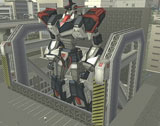 The mech genre
seems like a natural fit for videogames. Give me one of those killer
giant robots from any one of about a million anime flicks, arm it to the
teeth, and let me loose on a life-like city against some vile,
futuristic villains. Oh, yeah. Unfortunately, finding a good mech title
on a console system is about as likely as finding spiritual
enlightenment by watching the Anna Nicole Smith Show. Enix has
effectively changed that with the release of Robot Alchemic Drive.
The mech genre
seems like a natural fit for videogames. Give me one of those killer
giant robots from any one of about a million anime flicks, arm it to the
teeth, and let me loose on a life-like city against some vile,
futuristic villains. Oh, yeah. Unfortunately, finding a good mech title
on a console system is about as likely as finding spiritual
enlightenment by watching the Anna Nicole Smith Show. Enix has
effectively changed that with the release of Robot Alchemic Drive.
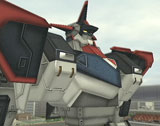 The story is one
you will recognize from just about every giant robot
videogame/television show/movie that you have ever seen: a futuristic
metropolis representing the peak of human civilization is being
threatened by a mysterious race of giant, warlike aliens. It is up to
three hip, young kids to save the world. At their disposal are three
incredibly powerful battle mechs. With various cities acting as the
battleground, your challenge is to take on the role of one of the kids,
arm your robot, and take down your enemy with as few human casualties as
possible.
The story is one
you will recognize from just about every giant robot
videogame/television show/movie that you have ever seen: a futuristic
metropolis representing the peak of human civilization is being
threatened by a mysterious race of giant, warlike aliens. It is up to
three hip, young kids to save the world. At their disposal are three
incredibly powerful battle mechs. With various cities acting as the
battleground, your challenge is to take on the role of one of the kids,
arm your robot, and take down your enemy with as few human casualties as
possible.
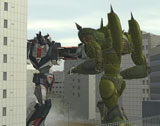 The genius
of the game, however, is where it breaks away from the stale mech
formula. RAD turns the genre on its ear by taking your point of view out
of the robot and placing it firmly on the ground. You have full control
of your chosen human character in the 3D environment. The game begins
with the arrival of the first alien, and you must guide your character
through the mayhem to a rendezvous point where you will be given the
controls to your mech. Then you must find a vantage point somewhere near
the battle where, hopefully, your line of site will remain unobstructed.
Battles are fought via remote control; you are never actually in the
robot itself. You can alternate control from the robot to the human
character at any time in the game.
The genius
of the game, however, is where it breaks away from the stale mech
formula. RAD turns the genre on its ear by taking your point of view out
of the robot and placing it firmly on the ground. You have full control
of your chosen human character in the 3D environment. The game begins
with the arrival of the first alien, and you must guide your character
through the mayhem to a rendezvous point where you will be given the
controls to your mech. Then you must find a vantage point somewhere near
the battle where, hopefully, your line of site will remain unobstructed.
Battles are fought via remote control; you are never actually in the
robot itself. You can alternate control from the robot to the human
character at any time in the game.
 This point of
view is brilliant. My primary complaint with all giant robot games is
that it never feels like you are controlling a giant robot. The scale
always seems to be muted, or simply relative to the other robot you are
fighting. There is never the sense of grandeur that seems to me would be
the point. But by placing you on the ground as two hulking monstrosities
hurl each other through buildings, the devastation becomes
overwhelming—bridges are falling, power lines are down, people are dead
in the streets, and there is a very real possibility that you may be
next. You better choose a safe place to stand, and even then be ready to
run, because if the battle moves too close it’s possible that the next
big hit will send one of the enormous robots crashing down on top of
you. There is nothing more humiliating than being squished by your own
fallen mech.
This point of
view is brilliant. My primary complaint with all giant robot games is
that it never feels like you are controlling a giant robot. The scale
always seems to be muted, or simply relative to the other robot you are
fighting. There is never the sense of grandeur that seems to me would be
the point. But by placing you on the ground as two hulking monstrosities
hurl each other through buildings, the devastation becomes
overwhelming—bridges are falling, power lines are down, people are dead
in the streets, and there is a very real possibility that you may be
next. You better choose a safe place to stand, and even then be ready to
run, because if the battle moves too close it’s possible that the next
big hit will send one of the enormous robots crashing down on top of
you. There is nothing more humiliating than being squished by your own
fallen mech.
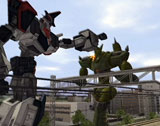 The game has
one more twist, however—the control set-up. Both strange and perfect,
the controls act more like a remote control device than your typical
videogame. The shoulder buttons control your legs so that you step
forward with your right leg by pressing R1, left with L1. To walk you
must alternate pressing the two buttons—right, left, right, left. R2 and
L2 step backward. R1+R2 turns right, L1+L2 turns left. You move your
arms with the right and left analogue sticks. Tipping the right analogue
stick forward results in a right jab. If you rotate the left stick 90
degrees, you get a left hook. Then you can move your torso with the
directional buttons—up to arch your back, down to bend over, right and
left to pivot at the waist. The mechs also have the ability to duck,
jump, pick up objects, and perform special moves. The button pad fires
projectile weapons like lasers and bombs, and, if applicable, transforms
your robot into a vehicle.
The game has
one more twist, however—the control set-up. Both strange and perfect,
the controls act more like a remote control device than your typical
videogame. The shoulder buttons control your legs so that you step
forward with your right leg by pressing R1, left with L1. To walk you
must alternate pressing the two buttons—right, left, right, left. R2 and
L2 step backward. R1+R2 turns right, L1+L2 turns left. You move your
arms with the right and left analogue sticks. Tipping the right analogue
stick forward results in a right jab. If you rotate the left stick 90
degrees, you get a left hook. Then you can move your torso with the
directional buttons—up to arch your back, down to bend over, right and
left to pivot at the waist. The mechs also have the ability to duck,
jump, pick up objects, and perform special moves. The button pad fires
projectile weapons like lasers and bombs, and, if applicable, transforms
your robot into a vehicle.
 That’s right,
some of the robots can transform. There are three robots to choose from.
One robot is light and fast and transforms into a jet. It is armed with
various missiles, a lightning ray, and can even turn its arms into
swords. Another is bulky and slow and transforms into a tank. It can
turn its fists into hammers, and its tank cannon has devastating fire
power. The last robot falls right into the middle and doesn’t transform,
although it does have that cool Shogun Warriors move where it shoots its
hand like a big, blunt missile. Or was that Voltron who did that? The
enemies range from big lizards, to sleek battle robots and massive
juggernauts.
That’s right,
some of the robots can transform. There are three robots to choose from.
One robot is light and fast and transforms into a jet. It is armed with
various missiles, a lightning ray, and can even turn its arms into
swords. Another is bulky and slow and transforms into a tank. It can
turn its fists into hammers, and its tank cannon has devastating fire
power. The last robot falls right into the middle and doesn’t transform,
although it does have that cool Shogun Warriors move where it shoots its
hand like a big, blunt missile. Or was that Voltron who did that? The
enemies range from big lizards, to sleek battle robots and massive
juggernauts.
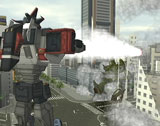 The graphics
range from phenomenal in the cut scenes, to very good in the battle
sequences, to somewhat poor in the overlapping storyboard elements. What
happens is every time someone talks to you the screen is overlapped with
a dialogue box and a close up of the character speaking, much like an
RPG. This seems a little out of place in this game, and it is a shame
because everything else is so good. During battle, everything within the
environment is destructible—if it stands you can knock it down. The
frame rate, performance, and special effects are terrific. And, as if
all of this weren’t enough, the character designs are by none other than
Toshihiro Kawamoto, of Cowboy Bebop fame.
The graphics
range from phenomenal in the cut scenes, to very good in the battle
sequences, to somewhat poor in the overlapping storyboard elements. What
happens is every time someone talks to you the screen is overlapped with
a dialogue box and a close up of the character speaking, much like an
RPG. This seems a little out of place in this game, and it is a shame
because everything else is so good. During battle, everything within the
environment is destructible—if it stands you can knock it down. The
frame rate, performance, and special effects are terrific. And, as if
all of this weren’t enough, the character designs are by none other than
Toshihiro Kawamoto, of Cowboy Bebop fame.
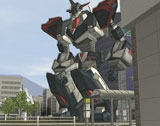 The sound is
far from perfect. Although the projectile weapons, explosions, roars,
stomps, and crashes are all great, the voice acting is among the most
horrible I have ever experienced. It is unconvincing, poorly performed,
and overall just painful and annoying. The music is generic.
The sound is
far from perfect. Although the projectile weapons, explosions, roars,
stomps, and crashes are all great, the voice acting is among the most
horrible I have ever experienced. It is unconvincing, poorly performed,
and overall just painful and annoying. The music is generic.
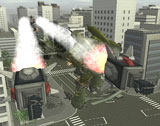 The
overlapping dialogue boxes and ridiculous voice acting are symptomatic
of the games biggest flaw: the story. The robots, point of view, and
control scheme of RAD add up to an incredible gameplay experience. In
truth, all it would have taken to propel the game is the simple set up
that I described earlier, the one that accompanies all mech stories.
While I applaud Enix’s attempt to give us a little more than one shallow
battle scenario after another, their delivery disrupts the flow of the
game in every way. The dialogue is poorly translated and goes on
forever. You find yourself laboriously scrolling through line after line
of inane banter and trite exposition just to get to the point where you
can play the game. Then, when you are finally in the game, right in the
middle of a tense battle, the action freezes as yet another dialogue box
pops up. They go so far as to actually interrupt your battles to make
you scroll through more dialogue! To add insult to injury, this dialogue
often only consists of useless observations of the battle that you were
enjoying before they butted in. Sometimes you don’t know whether to
laugh or cry. There is a point where one of the lead characters is
engulfed in a battle. As he dies he screams and, predictably, this
dialogue box pops up: "Aaaaaargh!" Then there are the annoying
performances—the irritating scientist; the mundane, foppish male lead;
even the one female human character is of the annoying giggle-box anime
variety rather than the kick-ass heroine kind. It kind of makes you wish
that the creators of this game had either been a little less ambitious
or a little more creative.
The
overlapping dialogue boxes and ridiculous voice acting are symptomatic
of the games biggest flaw: the story. The robots, point of view, and
control scheme of RAD add up to an incredible gameplay experience. In
truth, all it would have taken to propel the game is the simple set up
that I described earlier, the one that accompanies all mech stories.
While I applaud Enix’s attempt to give us a little more than one shallow
battle scenario after another, their delivery disrupts the flow of the
game in every way. The dialogue is poorly translated and goes on
forever. You find yourself laboriously scrolling through line after line
of inane banter and trite exposition just to get to the point where you
can play the game. Then, when you are finally in the game, right in the
middle of a tense battle, the action freezes as yet another dialogue box
pops up. They go so far as to actually interrupt your battles to make
you scroll through more dialogue! To add insult to injury, this dialogue
often only consists of useless observations of the battle that you were
enjoying before they butted in. Sometimes you don’t know whether to
laugh or cry. There is a point where one of the lead characters is
engulfed in a battle. As he dies he screams and, predictably, this
dialogue box pops up: "Aaaaaargh!" Then there are the annoying
performances—the irritating scientist; the mundane, foppish male lead;
even the one female human character is of the annoying giggle-box anime
variety rather than the kick-ass heroine kind. It kind of makes you wish
that the creators of this game had either been a little less ambitious
or a little more creative.
RAD’s saving grace is its two-player versus mode. As annoying as the
single player game can be when you are not duking it out with alien
marauders, at least you are opening up new characters and options for
one of the most intricate two-player robot battles ever created. RAD’s
complex and unique control set up requires that everyone involved spend
some time honing their skills. However, when you get two players of
comparable skill and experience together this game is amazing. The
articulation of the robot’s torso, appendages, weapons, special moves,
and transformations allow for all kinds of fighting styles and
strategies. You can switch from human to robot, maneuvering around
buildings in order to gain the advantage by obscuring the other player’s
line of site. You can try to move the battle closer to the other
player’s human character so that you can crush them with your foot,
debris, or their own robot. No two people will fight the same, and the
game leans more toward the contemplative fighter rather than the button-pounder.
Robot Alchemic Drive game is a one of a kind experience. I was truly
wowed by the scale and intensity of the battles. The robots are
incredible in both design and function. The point of reference and the
control scheme make this game stand out in a genre that is normally
mired in formula. While you will have to suffer through poorly executed
story elements that disrupt the flow of the game, the two-player mode
more than makes up for it. Mech lovers, put this one on your must play
list. You won’t regret it.
